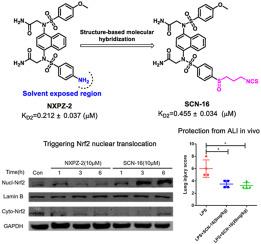European Journal of Medicinal Chemistry ( IF 6.0 ) Pub Date : 2021-06-05 , DOI: 10.1016/j.ejmech.2021.113599 Le Zhang 1 , Lijuan Xu 1 , Haihu Chen 2 , Wannian Zhang 1 , Chengguo Xing 3 , Zhuo Qu 4 , Jianqiang Yu 5 , Chunlin Zhuang 1

|
Blocking the Kelch-like epichlorohydrin-related protein 1 (Keap1)-nuclear factor-erythroid 2 related factor 2 (Nrf2) pathway represents as a promising strategy to reduce oxidative stress and related-inflammation, including acute lung injury (ALI). NXPZ-2, a naphthalensulfonamide derivative, was previously reported to effectively inhibit the Keap1-Nrf2 protein-protein interaction (PPI) by our group. In the present work, a series of novel isothiocyanate-containing naphthalensulfonamides with the thioether, sulfoxide and sulfone moieties were designed by a structure-based molecular hybridization strategy using NXPZ-2 and the Nrf2 activator sulforaphane. They possessed good Keap1-Nrf2 PPI inhibitory activity and low cytotoxicity. The molecular docking study was performed to further explain the different activity of the thioether-, sulfoxide- and sulfone-containing naphthalensulfonamides. Among these new derivatives, 2-((N-(4-((N-(2-amino-2-oxoethyl)-4-((3-isothiocyanatopropyl)sulfinyl)phenyl)sulfonamido) naphthalen-1-yl)-4-methoxyphenyl)sulfonamido)acetamide (SCN-16) showed a good KD2 value of 0.455 μM to disrupt the PPI. In an LPS-induced peritoneal macrophage cell model, this compound could cause a significant increase in the nuclear Nrf2 protein, decrease in the cytosolic Nrf2 protein, and further elevate the downstream protective enzymes HO-1 and NQO-1, which were better than the lead compound NXPZ-2 and sulforaphane. What's more, the production of ROS and NO and the expression of pro-inflammatory cytokine TNF-α were also suppressed. In the LPS-induced ALI model, SCN-16 could significantly reduce LPS-induced inflammations and alleviate lung injuries by triggering Nrf2 nuclear translocation. Collectively, our results suggested that SCN-16 could be a novel lead compound targeting Keap1-Nrf2 protective pathway for clinical treatment of ALI.
中文翻译:

Keap1-Nrf2抑制剂作为急性肺损伤新型保护剂的基于结构的分子杂交设计
阻断 Kelch 样表氯醇相关蛋白 1 (Keap1)-核因子-红细胞 2 相关因子 2 (Nrf2) 通路是减少氧化应激和相关炎症,包括急性肺损伤 (ALI) 的一种有前景的策略。NXPZ-2是一种萘磺酰胺衍生物,我们团队先前曾报道它可有效抑制 Keap1-Nrf2 蛋白-蛋白相互作用 (PPI)。在目前的工作中,使用NXPZ-2通过基于结构的分子杂交策略设计了一系列具有硫醚、亚砜和砜部分的新型含异硫氰酸酯萘磺酰胺。和 Nrf2 激活剂萝卜硫素。它们具有良好的 Keap1-Nrf2 PPI 抑制活性和低细胞毒性。进行分子对接研究以进一步解释含硫醚、亚砜和砜的萘磺酰胺的不同活性。在这些新衍生物中,2-((N-(4-((N-(2-amino-2-oxoethyl)-4-((3-isothiocyanatopropyl)sulfinyl)phenyl)sulfonamido)naphthalen-1-yl)-4 -甲氧基苯基)磺酰胺基)乙酰胺(SCN-16)显示出良好的 K D20.455 μM 的值以破坏 PPI。在 LPS 诱导的腹腔巨噬细胞模型中,该化合物可导致核 Nrf2 蛋白显着增加,胞质 Nrf2 蛋白减少,并进一步升高下游保护酶 HO-1 和 NQO-1,这优于先导化合物 NXPZ-2 和萝卜硫素。此外,ROS和NO的产生以及促炎细胞因子TNF-α的表达也受到抑制。在 LPS 诱导的 ALI 模型中,SCN-16可以通过触发 Nrf2 核易位显着减少 LPS 诱导的炎症并减轻肺损伤。总的来说,我们的结果表明SCN-16可能是一种新型先导化合物,靶向 Keap1-Nrf2 保护通路,用于临床治疗 ALI。


















































 京公网安备 11010802027423号
京公网安备 11010802027423号